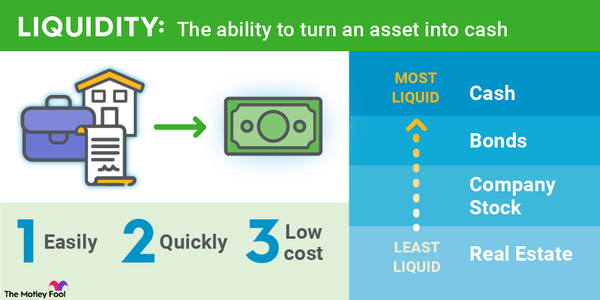Liquidity ratios determine if a business has the liquid assets to meet its current financial obligations without raising additional cash. They're a group of financial measurements that calculate a company's ability to satisfy its near-term financial obligations with current assets on its balance sheet or operating cash flow.
What are liquidity ratios?
What are liquidity ratios?
Liquidity is the lifeblood of a business. If a company doesn't have enough liquid assets (i.e., things it can convert to cash quickly, like marketable securities, accounts receivable, and inventory) to meet its current financial obligations, it might need to declare bankruptcy. Liquidity ratios help determine if a company has adequate liquidity to cover its current liabilities.
Liquidity ratios differ from solvency ratios. Liquidity ratios measure a company's ability to meet its current liabilities (i.e., those due within the next year). Solvency measures a company's ability to meet its financial obligations over the long term.
Important liquidity ratios
What are some important liquidity ratios?
There are several types of liquidity ratios. They use different inputs from a company's balance sheet or cash flow statement to determine its liquidity. Here are the four most important liquidity ratios:
1. The cash ratio
The cash ratio is the narrowest look at a company's liquidity. It calculates a company's liquidity using only its cash and equivalents on its balance sheet compared to its current liabilities.
The formula for the cash ratio is: cash ratio = (cash + cash equivalents) / current liabilities
2. The quick ratio
The quick ratio is the next level of a liquidity ratio. It adds a company's accounts receivable to its current assets since it should receive that cash over the next several weeks or months. The company should collect this money relatively quickly, hence the ratio's name.
The formula for quick ratio is: Quick ratio = (cash + cash equivalents + accounts receivable) / current liabilities
3. The current ratio
The current ratio (also sometimes called the working capital ratio) builds upon the quick ratio by adding inventory into the mix. A company's inventory is the finished products it could turn into cash in a relatively short period if it needed the funds.
The formula for the current ratio is: Current ratio = current assets (cash and equivalents + accounts receivable + inventory) / current liabilities
4. The operating cash flow ratio
The cash, quick, and current ratio calculate a company's liquidity based on inputs from its balance sheet. The operating cash flow ratio looks at liquidity through the lens of a company's cash flow statement. It examines whether a company generates enough operating cash flow to meet its financial obligations.
The formula for the operating cash flow ratio is: Operating cash flow / current liabilities
Why are liquidity ratios important?
Why are liquidity ratios important?
Liquidity ratios provide a sense of a company's financial health. They show whether a company has adequate liquidity to meet its upcoming financial obligations or if it might face a liquidity crunch.
A liquidity ratio of 1 or more suggests a company has more than enough liquid assets to cover its current liabilities. The higher the liquidity ratio, the better, because it implies the company has ample access to the liquid funds needed to meet its current liabilities.
A liquidity ratio of less than 1 is a warning sign. The level suggests the company might need to raise outside capital (e.g., selling assets, issuing stock, or borrowing more money) to help cover its current liabilities. If a company can't access external capital, it might declare bankruptcy.
Related Investing Topics
Examples
Examples of liquidity ratios in action
For the sake of this example, let's look at ABC Company. They ended the year with $21 billion of cash, $118.7 billion of marketable securities, $39.3 billion of net accounts receivable, and $1.2 billion of inventory. The company had $64.3 billion in total current liabilities. Meanwhile, their cash flow statement showed $91.7 billion in net cash from operating activities.
Here's a snapshot of their liquidity using the four common liquidity ratios:
- Cash ratio: $139.7 billion / $64.3 billion = 2.17
- Quick ratio: $179 billion / $64.3 billion = 2.78
- Current ratio: $180.2 billion /$64.3 billion = 2.80
- Operating cash flow ratio: $91.7 billion / $64.3 billion = 1.42
These calculations showcase that ABC Company has more than enough liquidity to meet its current liabilities. The strong liquidity ratios suggest the company is in excellent financial shape.











































